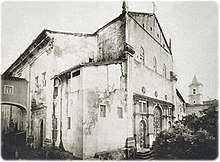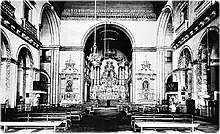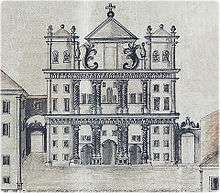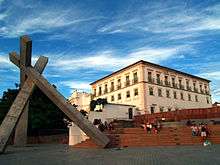Old Cathedral of Salvador
The Old Cathedral of Salvador (antiga Sé da Bahia in Portuguese) was the cathedral of the diocese and later archdiocese of Salvador da Bahia, Brazil, from the sixteenth century until 1765. In this year, the seat of the archdiocese moved to the current Cathedral of Salvador. Despite its historical significance, the Old Cathedral was demolished in 1933 under Archbishop Augusto Álvaro da Silva (1876-1968) during a wave of redevelopment in Salvador's historic center. Demolition of the cathedral allowed for tram routes into the historic center of the city, that were soon discontinued.[1] The current Cathedral of Salvador is a former Jesuit church.[2][3]
| Old Cathedral of Salvador (demolished) | |
|---|---|
Sé da Bahia (defunct) | |
 | |
| Religion | |
| Affiliation | Catholic |
| Rite | Roman Rite |
| Location | |
| Municipality | Salvador |
| State | Bahia |
| Country | Brazil |
| Architecture | |
| Style | Mannerist, Baroque |
| Demolished | 1933 |
History
The Diocese of São Salvador da Bahia de Todos os Santos, the first in the Portuguese colony of Brazil, was created in 1551, only two years after the foundation of Salvador by nobleman Tomé de Sousa. The first bishop, Pero Fernandes Sardinha, arrived in 1552. For several years, a small chapel constructed by the Jesuits served as the cathedral.
Construction
Construction on a new cathedral began during the rule of Tomé de Sousa. This site, outside the walls of Salvador's initial city settlement, was later known as the Terreiro de Jesus because it was dominated by the Jesuit college and church. The exact dates of construction are not known, but in 1570 Governor Mem de Sá wrote that the building was of stone masonry, with three naves.[4] Writing in 1587, explorer Gabriel Soares de Souza described it as "very well constructed and decorated, and two side altars flanking the main chapel."[5]

Another stage of cathedral construction began on the Old Cathedral of Salvador at the beginning of the seventeenth century, during the rule of Governor Gaspar de Souza (1612-1617). This building was located on the same site in the Terreiro de Jesus as the previous church, with the facade oriented to face the bay; but this time the interior was a single nave. During the Dutch Invasion in 1624, the Old Cathedral was used as a military base and was badly damaged when the Portuguese retook the city in 1625. The Diocese was vacant for a decade, recovering its bishop only in 1634 with the arrival of D. Pedro da Silva Sampaio. Starting in 1637, repairs were made on the Old Cathedral which was in poor condition.[4]
Reconstruction

In the second half of the seventeenth century, a major reconstruction project began in the Old Cathedral. This was a period when many colonial religious buildings were redone in a larger, more grandiose scale. Unfortunately, documents that record the definitive date or architect for this project do not survive, however it is probable that the building was designed in Portugal, given the attention that the central government gave to the work of the diocese. The cathedral was large for the period, with a facade flanked by two towers oriented towards the bay. The main structure was completed by the early eighteenth century, but the internal decorations (altars, floors, paintings, ceiling, etc.) were only completed in the 1730s.[4]
Historical records suggest that throughout the eighteenth century, the cathedral building suffered from neglect. In 1761 with the Jesuit expulsion from Brazil, their school and church in the Terreiro de Jesus became vacant.[6] In a letter dated 1765, King Joseph I offered to Archbishop D. José Botelho de Matos the former Jesuit Church as a temporary site until the Cathedral could be restored.[4]
Dilapidation
By the early nineteenth century, the Cathedral facade was falling into ruin, and its wall was repaired in an attempt to prevent the towers from falling. The wall itself fell into ruin, leading to the preventative demolition of the towers and a great part of the facade masonry. The enormous building, not preserved by ecclesiastical authorities, was transferred to the brotherhood of the Santíssimo Sacramento da Sé (Brotherhood of the Holy Sacrament). The brotherhood did some restoration work, including replacing some interior altarpieces.[4]
Demolition and commemoration

On August 7, 1933, after years of heated debates, the Old Cathedral of Salvador was demolished along with two other colonial buildings in Salvador's Historic Center as part of a larger urban renewal project. The destruction of these buildings allowed the extension of tram routes run by the Companhia Linha Circular de Carris da Bahia. Some interior elements of the Old Cathedral were transferred to other Catholic institutions in Salvador; its silver altar was moved to the Convent of Saint Theresa (Convento de Santa Teresa), now the "Museum of Sacred Art of Bahia". The new space created by the demolition of the Old Cathedral was named the Praça da Sé. Initially it served to store the new trolleys.[1][7]
Commemoration
In 1956, as homage to the religious and historical significance of the site, city officials erected a bronze bust of D. Pero Fernandes Sardinha, first Bishop of Brazil and a supporter of the construction of the first cathedral. In 1999, the sculptor Mário Cravo erected a stainless steel sculpture Cruz Caída (Fallen Cross) to commemorate the destruction of the historic Cathedral.[8]
References
- Assunção, Gabriela Lira; Dantas, George Alexandre Ferreira; Assunção, Gabriela Lira; Dantas, George Alexandre Ferreira (2018). "Demolições, debates e tentativas de preservação: aproximações a partir dos casos de Salvador e Recife (1910-1930)". Urbe. Revista Brasileira de Gestão Urbana. 10 (2): 387–399. doi:10.1590/2175-3369.010.002.ao05. ISSN 2175-3369.
- "A Sé Primacial do Brasil, a Primeira Catedral". www.bahia-turismo.com. Retrieved 2018-11-27.
- Instituto do Patrimônio Histórico e Artístico Nacional. "Catedral Basílica de Salvador".
- Lins, Eugénio de Ávila (2001). "A antiga Sé da Bahia: uma referência para a arte luso-brasileira". Anais do II Congresso Internacional do Barroco, Porto: 183–195.
- Sousa, Gabriel Soares de (1851). Tratado descriptivo do Brazil em 1587 (in Portuguese). Typographia Universal de Laemmert. pp. 119–120.
- Smith, Robert C. (1948). "Jesuit Buildings in Brazil". The Art Bulletin. 30 (3): 187–213. doi:10.2307/3047183. JSTOR 3047183.
- Vilaron, André (2007). Igrejas históricas de Salvador = Historical churches in Salvador. Brasília, Brazil: Ministério das Relações Exteriores, Governo Federal. ISBN 9788560123001.
- Cultural, Instituto Itaú. "Mario Cravo Júnior | Enciclopédia Itaú Cultural". Enciclopédia Itaú Cultural (in Portuguese). Retrieved 2018-11-27.